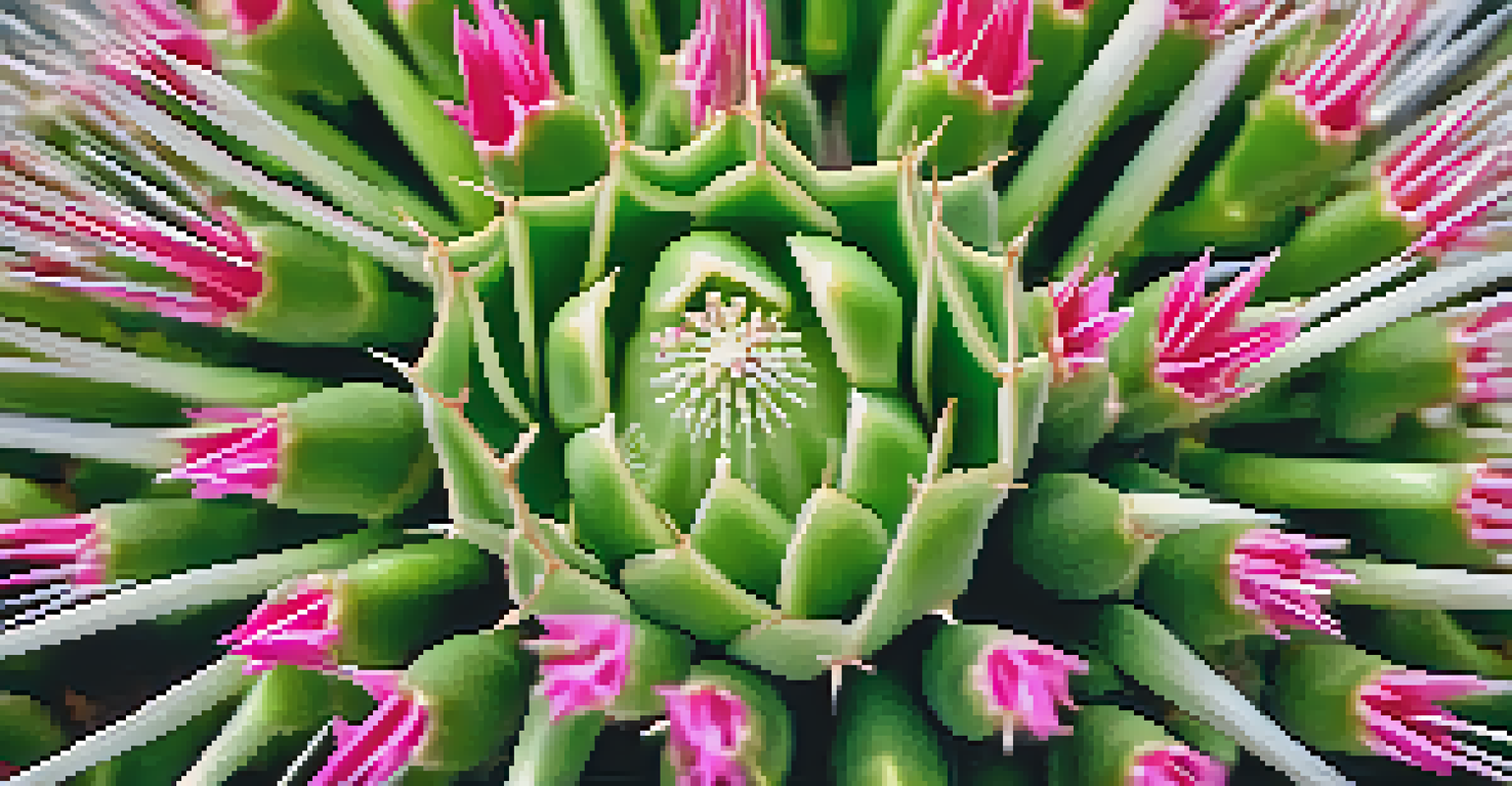Peyote and Shamanism: A Sacred Journey Through Altered States

Understanding Peyote: A Sacred Plant in Shamanism
Peyote, a small cactus native to North America, is renowned for its psychoactive properties. Traditionally, indigenous peoples have used it in religious rituals for centuries, believing it connects them to the spiritual realm. The key compound in peyote, mescaline, induces altered states of consciousness that many find enlightening or therapeutic.
Psychedelics can play a role in healing that is far more profound than anything we can offer in the way of pharmaceuticals.
Shamans, who serve as spiritual guides, often incorporate peyote into their healing practices. These ceremonies can help individuals confront personal challenges, gain insights, or achieve a sense of unity with the universe. The experience is deeply personal and varies widely depending on the individual and their intentions.
In many cultures, peyote is not just a tool for altered states; it symbolizes a bridge between the physical and spiritual worlds. This sacred status underscores the importance of respecting the plant and its traditional uses, particularly as the interest in psychedelics grows in modern society.
The Role of Shamanism in Healing Practices
Shamanism is a spiritual practice that dates back thousands of years, emphasizing the connection between humans and the spirit world. Shamans act as mediators, using various techniques—such as drumming, chanting, and dance—to enter altered states of consciousness. This allows them to communicate with spirits and seek guidance for healing.

During a peyote ceremony, the shaman plays a crucial role in guiding participants through their experiences. They create a safe space, often incorporating rituals that honor the plant and set intentions for the journey. This careful orchestration helps ensure that the experience is meaningful and transformative.
Peyote's Role in Spiritual Healing
Peyote is a sacred plant used in shamanic rituals to facilitate personal healing and insights through altered states of consciousness.
Many individuals have reported profound healing experiences during these ceremonies, often citing emotional release, clarity, and a renewed sense of purpose. These outcomes highlight the potential of shamanic practices combined with peyote to foster personal growth and healing.
The Peyote Experience: What to Expect
Consuming peyote typically leads to a journey that unfolds over several hours, marked by visual and auditory hallucinations. Participants often describe these altered states as vivid and sometimes overwhelming, filled with colors, patterns, and spiritual visions. The experience can feel both enlightening and challenging, plunging individuals into deep introspection.
The most important thing is that we honor the traditions and the wisdom of the Indigenous peoples who have used these plants for thousands of years.
As the journey progresses, many people report feelings of connectedness to nature and other beings. This sense of unity can be incredibly comforting, helping individuals feel less isolated in their struggles. However, it’s essential to approach these experiences with an open mind, as each person's journey can differ significantly.
Integration is a critical aspect of the peyote experience. After the ceremony, participants often reflect on their insights, which can lead to lasting changes in perspective and behavior. This process of understanding and incorporating lessons learned is vital for personal growth.
Cultural Significance of Peyote in Indigenous Traditions
For many Indigenous communities, peyote is not just a plant but a vital part of their cultural identity and spiritual practice. It has been used in religious ceremonies for centuries, symbolizing a connection to ancestors and the natural world. The rituals surrounding its use often involve storytelling, music, and communal bonding, reinforcing social ties.
The significance of peyote extends beyond personal experiences; it represents a collective journey for many tribes. These ceremonies are often held during important life events, such as births or initiations, highlighting the plant's role in marking significant transitions. This cultural context adds layers of meaning to the peyote experience.
Cultural Significance of Peyote
For Indigenous communities, peyote is integral to their cultural identity and spiritual practices, symbolizing connections to ancestors and the natural world.
In a world increasingly focused on individualism, the communal aspects of peyote ceremonies remind participants of the importance of community and shared experiences. This interconnectedness is a fundamental aspect of shamanism and is often emphasized during peyote rituals.
Modern Interest in Peyote and Psychedelics
In recent years, there has been a resurgence of interest in psychedelics, including peyote, for their potential therapeutic benefits. Researchers are exploring how these substances can aid in treating mental health conditions, such as depression, anxiety, and PTSD. This modern curiosity aligns with ancient practices, as many Indigenous cultures have long recognized the healing properties of peyote.
As more people seek alternative therapies, the dialogue around peyote's use is shifting. However, it’s essential to approach this interest with respect for Indigenous traditions and practices. Ethical considerations must be taken into account to ensure that these sacred plants are used appropriately and responsibly.
The growing body of research and anecdotal evidence surrounding peyote's benefits may pave the way for greater acceptance and understanding of its role in mental health. This renewed interest could also help preserve Indigenous knowledge and practices, fostering a deeper appreciation for the cultural significance of peyote.
Challenges Facing Peyote and Indigenous Practices
Despite the growing interest in peyote, Indigenous communities face numerous challenges that threaten their traditional practices. One major issue is the overharvesting of peyote, which endangers its natural populations. As demand increases, the plant's sustainability is at risk, putting both cultural practices and the ecosystem in jeopardy.
Additionally, the commercialization of peyote can dilute its sacredness and lead to exploitation. This shift towards commodification often overlooks the rich cultural history and spiritual significance embedded in its use. It raises ethical questions about who has the right to use peyote and for what purposes.
Challenges to Peyote Sustainability
Indigenous practices face threats from overharvesting and commercialization, risking both the plant's sustainability and the cultural significance of its use.
To address these challenges, it’s crucial to support Indigenous rights and advocate for the preservation of their traditional practices. Awareness and education around the cultural importance of peyote can help foster respect and understanding, ensuring that it remains a sacred part of Indigenous heritage.
The Future of Peyote and Shamanic Practices
As interest in peyote and shamanic practices continues to grow, the future holds both promise and challenges. The potential for healing and personal transformation is significant, but it comes with the responsibility to honor Indigenous traditions. This means engaging with these practices respectfully and ethically.
Education plays a vital role in shaping the future of peyote use. By learning about its cultural significance and the traditional practices surrounding it, individuals can approach their experiences with greater awareness and respect. This knowledge can help bridge the gap between modern interests and ancient wisdom.

Ultimately, the future of peyote and shamanism lies in collaborative efforts that respect Indigenous knowledge while exploring the potential benefits of these sacred practices. By fostering dialogue and understanding, we can ensure that the journey through altered states remains a profound and respectful exploration of the self and the universe.